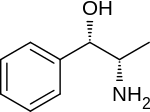Cathine
D-norpseudoephedrine, also known as cathine and (+)-norpseudoephedrine, is a psychoactive drug of the phenethylamine and amphetamine chemical classes which acts as a stimulant. Along with cathinone, it is found naturally in Catha edulis (khat), and contributes to its overall effects.[2] It has approximately 10–14% the potency of amphetamine (Adderall).[2]
 | |
 | |
| Clinical data | |
|---|---|
| Other names | (+)-norpseudoephedrine Cathine |
| Routes of administration | Oral |
| Drug class | Appetite suppressant CNS stimulant |
| ATC code | |
| Legal status | |
| Legal status |
|
| Pharmacokinetic data | |
| Elimination half-life | 1.8–8.6 hours[1] |
| Identifiers | |
| |
| CAS Number | |
| PubChem CID | |
| DrugBank | |
| ChemSpider | |
| UNII | |
| ChEMBL | |
| CompTox Dashboard (EPA) | |
| ECHA InfoCard | 100.007.050 |
| Chemical and physical data | |
| Formula | C9H13NO |
| Molar mass | 151.209 g·mol−1 |
| 3D model (JSmol) | |
| Solubility in water | 20 mg/mL (20 °C) |
| |
| |
| | |
Pharmacology
Like amphetamines, cathinone and ephedrine, cathine acts as a norepinephrine releasing agent (NRA).[2] It also acts as a dopamine releasing agent (DRA) to a lesser extent.[2]
Chemistry
Cathine is one of the four stereoisomers of phenylpropanolamine (PPA).
Regulation
The World Anti-Doping Agency's list of prohibited substances (used for the Olympic Games among other athletic events) bars cathine in concentrations of over 5 micrograms per milliliter in urine. Cathine is a Schedule III drug under the Convention on Psychotropic Substances.[3] In the United States, it is classified as a Schedule IV controlled substance.[4]
In Australia, Cathine is officially a schedule 4 drug but is not available or approved for any use.

In Hong Kong, cathine is regulated under Schedule 1 of Hong Kong's Chapter 134 Dangerous Drugs Ordinance. Unlawful possession is punishable by severe fines and imprisonment.
Pregnancy
Ephedra, found in many Ephedraceae species, is a Chinese and Western herb that contains, among other amphetamines, D-norpseudoephedrine. In the National Birth Defects Prevention Study, which included 18,438 women from 10 states from 1999–2003, 1.3% of women reported using ephedra during pregnancy. During the trial, five cases of anencephaly were born to women who used ephedra, however there was no statistically significant association to women not using ephedra (odds ratio 2.8, confidence interval 1.0–7.3).[5]
A small study of 642 participants in Yemen found that among pregnant women who chewed khat (containing D-norpseudoephedrine) there was no increased risk of stillbirth or congenital malformations.[6] Among lactating women who chew khat, D-norpseudoephedrine is found in breastmilk.[7]
See also
References
- Toennes SW, Harder S, Schramm M, Niess C, Kauert GF (July 2003). "Pharmacokinetics of cathinone, cathine and norephedrine after the chewing of khat leaves". British Journal of Clinical Pharmacology. 56 (1): 125–30. doi:10.1046/j.1365-2125.2003.01834.x. PMC 1884326. PMID 12848785.
- Hoffman R, Al'Absi M (December 2010). "Khat use and neurobehavioral functions: suggestions for future studies". Journal of Ethnopharmacology. 132 (3): 554–63. doi:10.1016/j.jep.2010.05.033. PMC 2976806. PMID 20553832.
- "List of psychotropic substances under international control" (PDF). International Narcotics Control Board. Archived from the original (PDF) on 2012-08-31.
- "Scheduling Actions" (PDF). Diversion Control Division. U.S. Department Of Justice, Drug Enforcement Administration (DEA).
- SMID, Marcela C.; Metz, Torri D.; Gordon, Adam J. (March 2019). "Stimulant Use in Pregnancy – an under-recognized epidemic among pregnant women". Clinical Obstetrics and Gynecology. 62 (1): 168–184. doi:10.1097/GRF.0000000000000418. ISSN 0009-9201. PMC 6438363. PMID 30601144.
- M, Nakajima; Mg, Jebena; M, Taha; M, Tesfaye; E, Gudina; A, Lemieux; R, Hoffman; M, al'Absi (October 2017). "Correlates of Khat Use During Pregnancy: A Cross-Sectional Study". Addictive Behaviors. 73: 178–184. doi:10.1016/j.addbeh.2017.05.008. PMID 28531823.
- B, Kristiansson; N, Abdul Ghani; M, Eriksson; M, Garle; A, Qirbi (September 1987). "Use of Khat in Lactating Women: A Pilot Study on Breast-Milk Secretion". Journal of Ethnopharmacology. 21 (1): 85–90. doi:10.1016/0378-8741(87)90097-3. PMID 3695559.